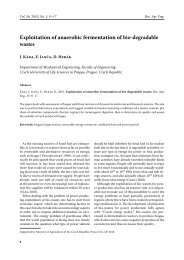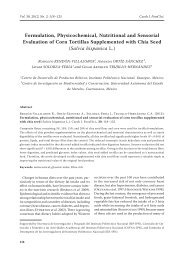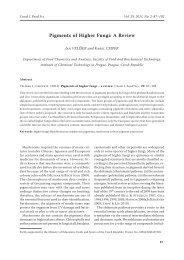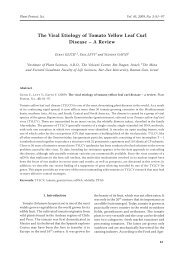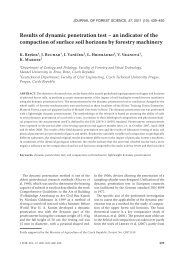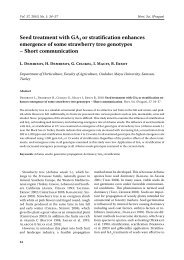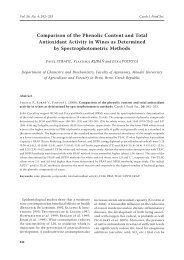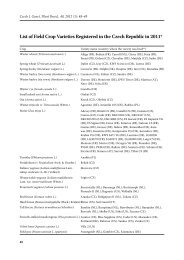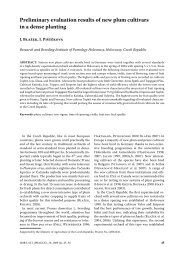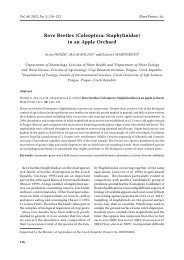Trans Fatty Acid Contents in Chocolates and Chocolate Wafers in ...
Trans Fatty Acid Contents in Chocolates and Chocolate Wafers in ...
Trans Fatty Acid Contents in Chocolates and Chocolate Wafers in ...
Create successful ePaper yourself
Turn your PDF publications into a flip-book with our unique Google optimized e-Paper software.
Czech J. Food Sci. Vol. 28, 2010, No. 3: 177–184<br />
study, we analysed more chocolate samples for<br />
fatty acids composition <strong>and</strong> TFAs content than did<br />
Karabulut (2007). Similarly, we found that bitter<br />
chocolates were trans free products. Karabulut<br />
(2007) found that chocolate bar <strong>and</strong> coconut bar<br />
covered with chocolate conta<strong>in</strong>ed the highest lauric<br />
acid (24.87–13.60%) <strong>and</strong> myristic acid (9.38–9.27%)<br />
contents. Similarly, <strong>in</strong> our study, pure chocolate<br />
wafers <strong>and</strong> chocolate wafers with nuts conta<strong>in</strong>ed<br />
higher levels of lauric (5.11–4.08%) <strong>and</strong> myristic<br />
(2.97–2.14%) acids than other groups.<br />
Mojska et al. (2006) determ<strong>in</strong>ed TFAs <strong>in</strong> foods <strong>in</strong><br />
Pol<strong>and</strong> <strong>in</strong>clud<strong>in</strong>g 12 chocolate products. TFAs were<br />
detected to make 7.86% <strong>in</strong> the chocolate products.<br />
We observed that the m<strong>in</strong>imum–maximum range<br />
of TFAs content was 0.00–6.23% for chocolates <strong>and</strong><br />
0.00–7.92% for chocolate wafers. Innis et al. (1999)<br />
determ<strong>in</strong>ed TFAs content <strong>in</strong> over 200 foods <strong>in</strong>clud<strong>in</strong>g<br />
9 chocolate bars <strong>in</strong> Canada. They observed that<br />
TFAs content varied between 0.1% <strong>and</strong> 35.9% with<br />
average values 9.16% <strong>in</strong> chocolate bars. They stated<br />
that the use of average values for theTFAs content<br />
<strong>in</strong> a food category was of a limited value.<br />
Fu et al. (2008) <strong>in</strong>vestigated TFAs <strong>in</strong> nationalbr<strong>and</strong><br />
western-style products <strong>in</strong>clud<strong>in</strong>g 10 chocolate<br />
samples <strong>in</strong> Ch<strong>in</strong>a. The authors determ<strong>in</strong>ed<br />
the average contents of TFAs as 0.80%, 0.57%, <strong>and</strong><br />
1.87% of total fatty acids <strong>in</strong> chocolate with nuts,<br />
dark chocolate, <strong>and</strong> milk chocolate, respectively.<br />
In our study, we determ<strong>in</strong>ed the average TFAs<br />
contents as 1.02%, 0.00%, <strong>and</strong> 0.18% of total fatty<br />
acids <strong>in</strong> chocolate with nuts, bitter chocolate, <strong>and</strong><br />
milk chocolate, respectively.<br />
The body of short-term r<strong>and</strong>omised feed<strong>in</strong>g<br />
trials suggest that cocoa <strong>and</strong> chocolate may exert<br />
beneficial effects on cardiovascular risk via<br />
lower<strong>in</strong>g the blood pressure, anti-<strong>in</strong>flammation,<br />
anti-platelet function, higher HDL, <strong>and</strong> decreased<br />
LDL oxidation (D<strong>in</strong>g et al. 2006). Similarly, Mursu<br />
et al. (2004) stated that cocoa polyphenols may<br />
<strong>in</strong>crease the concentration of HDL cholesterol.<br />
The consumption of cocoa with dark chocolate<br />
<strong>in</strong>creased the serum concentration of HDL cholesterol<br />
by 4% (Wan et al. 2001). Cocoa butter, a<br />
fat derived from cocoa plants <strong>and</strong> predom<strong>in</strong>antly<br />
found <strong>in</strong> dark chocolate (Kris-Etherton et al.<br />
1993) conta<strong>in</strong>s on average 33% of oleic acid, 25%<br />
of palmitic acid, <strong>and</strong> 33% of stearic acid (USDA<br />
National Nutrient Database http://www.nal.usda.<br />
gov/fnic/foodcomp/search/). Similarly, <strong>in</strong> our<br />
study, <strong>in</strong> bitter chocolates, palmitic, oleic, <strong>and</strong><br />
stearic acids contents were determ<strong>in</strong>ed as 25.11%,<br />
33.80%, <strong>and</strong> 34.66%, respectively. Stearic acid was<br />
suggested to be a non-atherogenic type of dietary<br />
saturated fat (D<strong>in</strong>g et al. 2006) <strong>and</strong> the most recent<br />
trial also shows the effects of stearic acid on lipids<br />
to be even similar to those of oleic <strong>and</strong> l<strong>in</strong>oleic<br />
acids (Thijssen & Mens<strong>in</strong>k 2005).<br />
The results of this research have demonstrated<br />
that fatty acids composition <strong>and</strong> TFAs contents<br />
of chocolate vary. As a result of the extensive coverage<br />
of the present research which <strong>in</strong>cluded all<br />
chocolate <strong>and</strong> chocolate wafers br<strong>and</strong>s <strong>in</strong> Turkey, it<br />
was shown that trans fatty acid levels <strong>in</strong> chocolates<br />
<strong>and</strong> chocolate wafers on Turkish markets were<br />
relatively lower than those of other countries.<br />
r e f e r e n c e s<br />
Ascherio A., Willet W.C. (1997): Health effects of<br />
trans fatty acids. American Journal of Cl<strong>in</strong>ical Nutrition,<br />
66: 1006–1010.<br />
Ayagari A., Peepies J.M., Carlson S.E. (1996): Relationship<br />
of isomeric-fatty acids <strong>in</strong> human cord blood to<br />
N3 <strong>and</strong> N6 status. Pediatric Research, 39: 1808–1808<br />
(Abstract).<br />
Basol B., Tasan M. (2008): <strong>Fatty</strong> acid compositions of<br />
Turkish shorten<strong>in</strong>gs with emphasis on trans fatty acids.<br />
Journal of Food Lipids, 15: 240–250.<br />
Cet<strong>in</strong> M., Yildirim A., Sah<strong>in</strong> A.M. (2003): Determ<strong>in</strong>ation<br />
of fatty acids <strong>and</strong> some undesirable fatty acid isomers<br />
<strong>in</strong> selected Turkish margar<strong>in</strong>es. European Journal<br />
of Lipid Science <strong>and</strong> Technology, 105: 683–687.<br />
Daglioglu O., Tasan M. (2003): <strong>Fatty</strong> acid composition<br />
of traditional fermented <strong>and</strong> unfermented Turkish corn<br />
bread with the emphasis on trans fatty acids. European<br />
Food Research <strong>and</strong> Technology, 217: 125–127.<br />
Demirbas A., Yilmaz N. (2000): trans fatty acid content<br />
of edible margar<strong>in</strong>es <strong>in</strong> Turkey. Deutsche Lebensmittel-Rundschau,<br />
96: 136–138.<br />
Demmelmair H., Festl B., Wolfram G., Koletzko<br />
B. (1996): trans fatty acid contents <strong>in</strong> spreads <strong>and</strong><br />
cold cuts usually consumed by children. Zeitschrift<br />
für Ernährungswissenschaft, 35: 235–240.<br />
D<strong>in</strong>g E.L., Hutfless S.M., D<strong>in</strong>g X., Girotra S. (2006):<br />
<strong>Chocolate</strong> <strong>and</strong> prevention of cardiovascular disease: A<br />
systematic review. Nutrition & Metabolism, 3: 1–12.<br />
Folch J., Lees M., Sloane Stanley G.H. (1957): A<br />
simple method for the isolation <strong>and</strong> purification of<br />
total lipides from animal tissues. Journal of Biological<br />
Chemistry, 226: 497–509.<br />
Fritsche J., Ste<strong>in</strong>hart H. (1998): Analysis, occurence,<br />
<strong>and</strong> physiological properties of trans fatty acids (TFA)<br />
183




